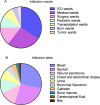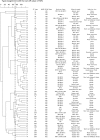Assessing Molecular Epidemiology of Carbapenem-resistant Klebsiella pneumoniae (CR-KP) with MLST and MALDI-TOF in Central China
- PMID: 30783127
- PMCID: PMC6381170
- DOI: 10.1038/s41598-018-38295-8
Assessing Molecular Epidemiology of Carbapenem-resistant Klebsiella pneumoniae (CR-KP) with MLST and MALDI-TOF in Central China
Abstract
Carbapenem-resistant K. pneumoniae (CR-KP) posts significant public health challenge worldwide. The aim of this study is to assess clinical characteristics and molecular epidemiology of CR-KP infections with Multilocus sequence typing (MLST) and Matrix-assisted laser desorption ionization-time of flight mass spectrometry (MALDI-TOF) in Central China. A total of 71 CR-KP isolates were recovered in a teaching hospital from October 2014 to December 2015. Among all CR-KP isolates, 73.2% (52) produced K. pneumoniae carbapenemases-2 (KPC-2). Eighteen ST types were identified by MLST, among these ST types, forty-seven isolates belonged to ST11 type, which was the predominant outbreak strain in China, and most ST11 isolates produced KPC-2. Eleven mass spectrometry (MS) types were identified by MALDI-TOF MS analysis, 53.5% isolates were MS4 and MS6, which matched with ST11 in MLST analysis. CR-KP infection was associated with increased medical cost and longer hospitalization. Therefore, we found that KPC-2-producing ST11 (MS4 and MS6) CR-KP isolates were the predominant clone identified by MLST and MALDI-TOF, and CR-KP infection was associated with increased hospital costs and longer hospitalization.
Conflict of interest statement
The authors declare no competing interests.
Figures




References
Publication types
MeSH terms
Substances
LinkOut - more resources
Full Text Sources
Medical

